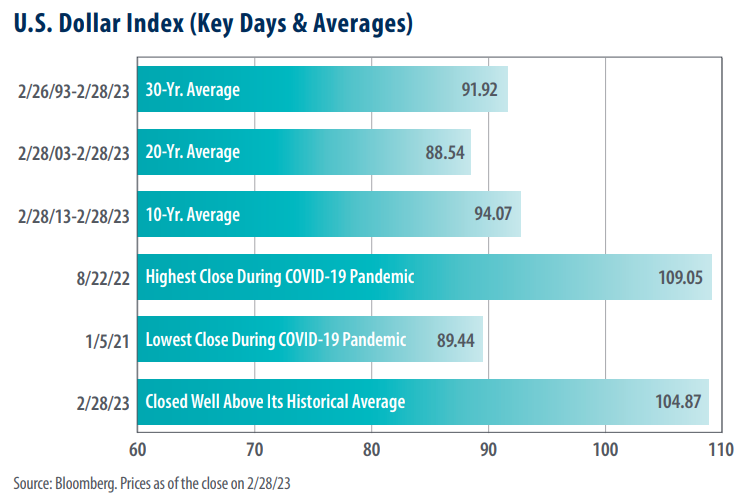
View from the Observation Deck
We get asked from time to time what our take is on the U.S. dollar and where we think it may be headed next. The dollar is still regarded as the world’s primary reserve currency. Its relative strength over time can be influenced by such things as central bank monetary policy, geopolitics and trade. U.S. investors with exposure to foreign securities, commodities and the stocks of U.S. multinational companies are particularly vulnerable to fluctuations in the U.S. dollar.
Predicting the direction of the dollar, or any currency, can be a daunting task, even for professionals who specialize in it. One thing we can provide is some context.
As indicated in the chart above, as of 2/28/23, the 10-, 20- and 30-year averages for the U.S. Dollar Index (DXY) registered readings of 94.07, 88.54 and 91.92, which is a relatively tight range over a span of 30 years (the mean of the three averages is 91.51). Furthermore, over the past 30 years, the index peaked at a reading of 120.90 on 7/5/01, while hitting a period low of 71.33 on 4/22/08, according to Bloomberg.
The U.S. Dollar Index remains elevated when compared to each of the averages in the chart.
In the past 12 months, the U.S. Dollar Index ranged from as low as 96.71 (2/28/22) to as high as 114.11 (9/27/22). Additionally, the U.S. Dollar Index has closed trading above the 100 mark in every trading session since 4/13/22, according to data from Bloomberg. The relative value of the dollar has been boosted by the Federal Reserve’s (“Fed”) aggressive rate hikes and forward guidance as well as foreign investors using the dollar as a safe haven over the past year as the war between Russia and Ukraine continued, in our opinion.
Takeaway
It does not surprise us to see that the U.S. Dollar Index currently stands higher than its 10-, 20- and 30- year averages (as depicted in today’s chart). In our view, the relative value of the U.S. dollar has been boosted by the Fed’s rate hikes, the continuation of its quantitative tightening program to pare down the assets on its balance sheet (at a pace of up to $95 billion per month), and foreign investors using the dollar as a safe haven destination as the war between Russia and Ukraine rages on. Additionally, if January’s strong jobs report and higher than expected inflation data lead the Fed to tighten interest rates even more, we could see the dollar’s value increase further, in our opinion.



